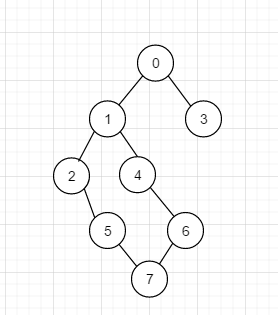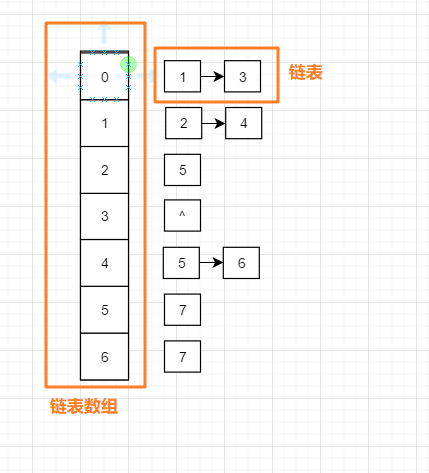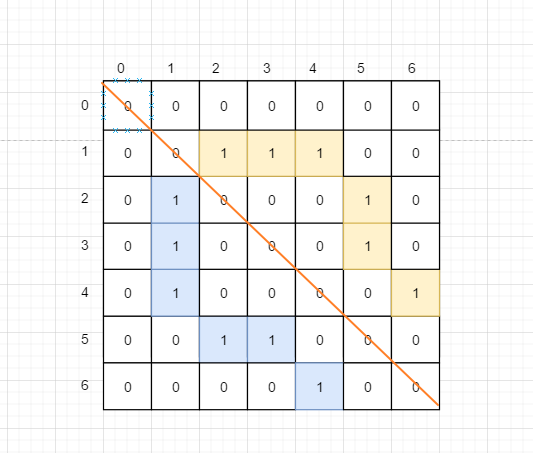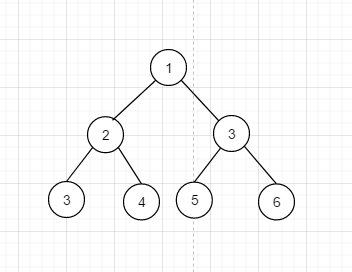深度优先搜索 & 广度优先搜索
假如我们有如下无向图

如果我们想对其进行深度优先遍历的话, 其实情况不止一种, 比如 0 1 2 5 7 6 4 3
下面介绍使用临接表法对其进行遍历, 一般邻接表长下面这样:
**思路: ** 参照上下两图我们可以发现, 邻接表中的左半部分是一个链表数组, 0-6 一共7个位置, 每一个位置上都对应一个链表, 比如 下面的 位置0 , 表示它是第一个节点, 右边的链表中的node1 和 node3 分别表示他们的位置0处节点的相邻节点,

深度优先就是一条路走到黑, 走不下去了就往回退, 所以通常使用递归;
思路:
比如我们从node0开始, 然后可以往node1 也可以往node3 , 随便选一个 node1 , 再从node1开始往下走, 我们可以到node2 或者 node4 --- 这种走法结合上图来看, 翻译一下就是下面这样
封装邻接表
public class Graph {
private int size;
// 链表数组实现邻接表
private LinkedList Integer list[];
public Graph(int size) {
this.size size;
list new LinkedList[size];
for (int i i size; i ) {
list[i] new LinkedList ();
* 接收两个顶点 , 添加边
* param a
* param b
public void addEdge(int a, int b) {
list[a].add(b);
list[b].add(a);
public static void main(String[] args) {
Graph graph new Graph(8);
graph.addEdge(0, 1);
graph.addEdge(0, 3);
graph.addEdge(1, 2);
graph.addEdge(1, 4);
graph.addEdge(2, 5);
graph.addEdge(4, 5);
graph.addEdge(4, 6);
graph.addEdge(5, 7);
graph.addEdge(6, 7);
graph.dfs(0);
}深度优先遍历
public void dfs(int start) {
boolean[] visited new boolean[this.size];
dodfs(start, this.list, visited);
* 递归深度搜索
* param list
* param visited
private void dodfs(int start, LinkedList Integer [] list, boolean[] visited) {
// 检查当前节点有没有被访问过
if (visited[start]) {
return;
System.out.println(start);
visited[start] true;
for (int i i this.list[start].size(); i ) {
int node this.list[start].get(i);
dodfs(node, list, visited);
}
还是看这个图, 广度优先遍历的话,就是按层遍历 , 比如 0 1 3 2 4 5 6 7
其实这样的话再不能使用递归设计函数了, 其实我当时应该能判断出来, 递归的话容易往图的一边跑, 一边遍历完事后才可能进行另一面的遍历, 可惜了,被问蒙了...
广度优先的思路:
使用一个队列来辅助完成, 思路如下
将当前节点添加进队列打印当前节点的值遍历当前节点的邻接表中的节点如果节点曾经被访问过, 跳过,不处理他如果当前节点没有被访问过, 并且队列中现在没有这个节点, 就将它添加进队列移除并得到 头节点将头结点在辅助数组visited中的标记 置为 true , 标识这个节点被访问过了更新位置标记, 什么标记呢? 就是当前队列头位置的node , 在邻接表中的位置代码如下:
/**
* 广度优先搜索
* param start
public void bfs(int start) {
boolean[] visited new boolean[this.size];
dobfs(start, visited, this.list);
* 广度优先搜索
* param start
* param visited
* param list
private void dobfs(int start, boolean[] visited, LinkedList Integer [] list) {
Queue Integer queue new LinkedList ();
queue.add(start);
while (queue.size() 0) {
// 打印当前的节点
System.out.println(queue.peek());
for (int i i this.list[start].size(); i ) {
if (visited[this.list[start].get(i)]) {
continue;
* 解决下面情况
* / \
* 2 3
* \ /
if (!queue.contains(this.list[start].get(i))){
queue.add(this.list[start].get(i));
// 移除头结点
Integer poll queue.poll();
visited[poll] true;
// 更新start值
if (queue.size() 0) {
start queue.peek();
}**什么是临接数组? **
如下图:

转换成临接矩阵长下面这样, 很清晰的可以看出, 左下角和右上角是对称的, 怎么解读下面的图形呢?
它其实就是一个二维数组 int [权重][X] 二维数组可以理解成数组嵌套数组, 因此前面的 X 其实对应的下图中的一行, 即 一个小数组
最左边的 纵向坐标是 0 1 2 3 分别表示当前节点的 权值下图中的每一行都代表着前面的权值对应的 临接点的数量0 表示不是它的临接点 , 1 表示是临接点
创建邻接表的代码如下
public class Graph1 {
//顶点数
private int numVertexes;
// 边数
private int numEdges;
// 记录顶点
int[] vertexes;
// 二维数组图
private int[][] points;
// 用于标记某个点是否被访问过的 辅助数组
private boolean[] visited;
private Scanner scanner new Scanner(System.in);
public Graph1(int numVertexes, int numEdges) {
this.numEdges numEdges;
this.numVertexes numVertexes;
// 初始化邻接矩阵
this.points new int[numVertexes][numVertexes];
// 初始化存放顶点的数组
this.vertexes new int[numVertexes];
// 标记已经访问过的数组
this.visited new boolean[this.numVertexes];
// 构建无向图
public int[][] buildGraph() {
System.out.println( 请输入顶点的个数
this.numVertexes scanner.nextInt();
System.out.println( 请输入边数
this.numEdges scanner.nextInt();
// 构建临接矩阵
for (int i i this.numEdges; i ) {
System.out.println( 请输入点(i,j)的 i 值
int i1 scanner.nextInt();
System.out.println( 请输入点(i,j)的 j 值
int j1 scanner.nextInt();
this.points[i1][j1]
this.points[j1][i1]
return this.points;
}深度优先搜索
思路: 深度优先依然使用递归算法
打印当前节点的值标记当前节点已经被访问过了遍历当前节点的临接矩阵如果发现遍历的节点为0 , 不处理, 继续遍历如果发现遍历的节点为1 , 但是已经被标记访问过了, 不处理, 继续遍历如果发现节点值为1 , 且没有被访问过, 递归重复123步骤/**
* 深度搜索
* param arr 待搜索的数组
* param value 顶点上的值
public void dfs(int[][] arr, int value) {
System.out.println(value);
visited[value] true;
for (int i i arr.length; i ) {
if (arr[value][i] ! 0 !visited[i]) {
dfs(arr, i);
}思路: 广度优先遍历临接矩阵和上面说的邻接表大致相同, 同样需要一个辅助队列
将头结点添加到队列中打印头结点的值遍历头结点的临接矩阵如果发现遍历的节点为0 , 不处理, 继续遍历如果发现遍历的节点为1 , 但是已经被标记访问过了, 不处理, 继续遍历如果发现节点值为1 , 且没有被访问过, 且队列中没有这个值 , 重复 123步骤/***
* 广度优先遍历
* param arr
* param headValue
public void bfs(int[][] arr, int headValue) {
Queue Integer queue new LinkedList ();
queue.add(headValue);
while (queue.size() 0) {
System.out.println(queue.peek());
for (int i i arr[headValue].length; i ) {
if (arr[headValue][i] 1 !visited[i] !queue.contains(i)) {
queue.add(i);
// 头节点出队
Integer poll queue.poll();
visited[poll] true;
// 更新headValue;
if (queue.size() 0){
headValue queue.peek();
}假设我们有下面这个二叉树,

下面我们使用不同的方式遍历它, 如果是深度优先的话, 情况依然是不确定的, 只要是符合一条路走到头, 没路可走再回退就ok , 比如 1 3 6 5 2 3 4
下面使用java提供的栈这个数据结构辅助完成遍历的过程
**思路: **
将头节点压入栈弹出栈顶的元素打印弹出的栈顶的元素的值处理栈顶元素的子节点如果存在左子节点, 将做子节点压入栈如果存在右子节点, 将右子节点压入栈重复 2 3 4 过程.../**
* 深度优先搜索
* param node
private static void dfs( Node node) {
Stack Node stack new Stack();
stack.push(node);
while (!stack.isEmpty()) {
Node pop stack.pop();
System.out.println(pop.getValue());
if (pop.getLeftNode()! null){
stack.push(pop.getLeftNode());
if (pop.getRightNode()! null){
stack.push(pop.getRightNode());
}思路: 广度优先遍历 同样是借助于辅助队列
将顶点添加进队列打印这个节点的值处理当前这个压入栈的左右子节点如果存在左节点, 将左节点存入队列如果存在右节点, 将右节点存入队列将头结点出队重复 2 3 4过程/**
* 广度优先搜索
* param node
private static void bfs( Node node) {
Queue Node queue new LinkedList ();
queue.add(node);
while (queue.size() 0){
System.out.println(queue.peek().getValue());
// 将左右节点入队
if (queue.size() 0){
Node nd queue.poll();
if (nd.getLeftNode()! null){
queue.add(nd.getLeftNode());
if (nd.getRightNode()! null){
queue.add(nd.getRightNode());
}leetcode-深度优先与广度优先遍历 深度优先遍历与广度优先遍历,不刷算法题不知道这两个概念,平时业务也有些过这种场景,但是一遇到这两词就感觉高大上了
一文搞懂深度优先搜索、广度优先搜索(dfs、bfs) 你问一个人听过哪些算法,那么深度优先搜索(dfs)和宽度优先搜索(bfs)那肯定在其中,很多小老弟学会dfs和bfs就觉得好像懂算法了,无所不能,确实如此,学会dfs和bfs暴力搜索枚举确实利用计算机超强计算大部分都能求的一份解,学会dfs和bfs去暴力杯混分是一个非常不错的选择!
深度优先搜索 深度优先搜索算法(英语:Depth-First-Search,DFS)是一种用于遍历或搜索树或图的算法。沿着树的深度遍历树的节点,尽可能深的搜索树的分支。当节点v的所在边都己被探寻过,搜索将回溯到发现节点v的那条边的起始节点。这一过程一直进行到已发现从源节点可达的所有节点为止。如果还存在未被发现的节点,则选择其中一个作为源节点并重复以上过程,整个进程反复进行直到所有节点都被访问为止。属于盲目搜索。
相关文章
- Lintcode: Nuts & Bolts Problem
- Remove console.logs with Webpack & Uglify
- Android逆向之旅---破解"穿靴子的猫"游戏的收费功能
- 三剑客之sed&grep
- 【企鹅电竞直播源】浏览器抓取真实直播源地址(纯前端JS & PHP解析源码)
- 文件传输工具FileZilla&WinSCP
- SG 函数初步 HDU 1536 && HDU 1944
- STM32F103RB, KEIL编译出错:cannot open preprocessing output output file ".神舟i号main.d" no such file or
- HDU5187 zhx's contest(计数问题)
- 25个Java机器学习工具&库--转载
- 学习笔记(16):Python网络编程&并发编程-开启子进程的两种方式

